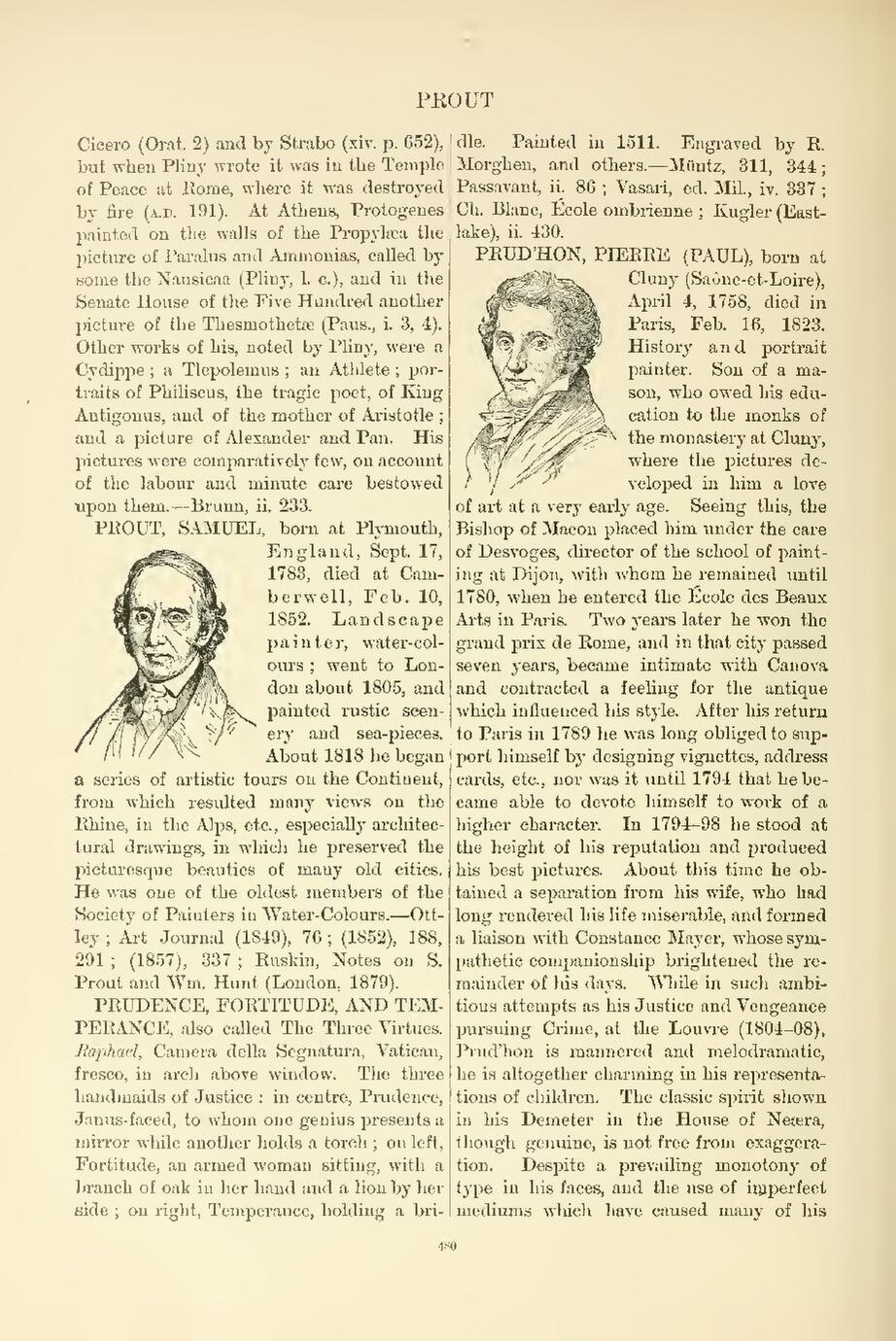Cicero (Orat. 2) and by Strabo (xiv. p. 652), but when Pliny wrote it was in the Temple of Peace at Rome, where it was destroyed by fire (A.D. 191). At Athens, Protogenes painted on the walls of the Propylæa the picture of Paralus and Ammonias, called by some the Nausicaa (Pliny, l. c.), and in the Senate House of the Five Hundred another picture of the Thesmothetæ (Paus., i. 3, 4). Other works of his, noted by Pliny, were a Cydippe; a Tlepolemus; an Athlete; portraits of Philiscus, the tragic poet, of King Antigonus, and of the mother of Aristotle; and a picture of Alexander and Pan. His pictures were comparatively few, on account of the labour and minute care bestowed upon them.—Brunn, ii. 233.
PROUT, SAMUEL, born at Plymouth,
England, Sept. 17,
1783, died at Camberwell,
Feb. 10,
1852. Landscape
painter, water-colours;
went to London
about 1805, and
painted rustic scenery
and sea-pieces.
About 1818 he began
a series of artistic tours on the Continent,
from which resulted many views on the
Rhine, in the Alps, etc., especially architectural
drawings, in which he preserved the
picturesque beauties of many old cities.
He was one of the oldest members of the
Society of Painters in Water-Colours.—Ottley;
Art Journal (1849), 76; (1852), 388,
291; (1857), 337; Ruskin, Notes on S.
Prout and Wm. Hunt (London, 1879).
An image should appear at this position in the text. To use the entire page scan as a placeholder, edit this page and replace "{{missing image}}" with "{{raw image|Cyclopedia of painters and paintings (IA cyclopediaofpain03cham).pdf/502}}". Otherwise, if you are able to provide the image then please do so. For guidance, see Wikisource:Image guidelines and Help:Adding images. |
PRUDENCE, FORTITUDE, AND TEMPERANCE, also called The Three Virtues. Raphael, Camera della Segnatura, Vatican, fresco, in arch above window. The three handmaids of Justice: in centre, Prudence, Janus-faced, to whom one genius presents a mirror while another holds a torch; on left, Fortitude, an armed woman sitting, with a branch of oak in her hand and a lion by her side; on right, Temperance, holding a bridle. Painted in 1511. Engraved by R. Morghen, and others.—Müntz, 311, 344; Passavant, ii. 86; Vasari, ed. Mil., iv. 337; Ch. Blanc, École ombrienne; Kugler (Eastlake), ii. 430.
An image should appear at this position in the text. To use the entire page scan as a placeholder, edit this page and replace "{{missing image}}" with "{{raw image|Cyclopedia of painters and paintings (IA cyclopediaofpain03cham).pdf/502}}". Otherwise, if you are able to provide the image then please do so. For guidance, see Wikisource:Image guidelines and Help:Adding images. |
PRUD'HON, PIERRE (PAUL), born at
Cluny (Saône-et-Loire),
April 4, 1758, died in
Paris, Feb. 16, 1823.
History and portrait
painter. Son of a mason,
who owed his education
to the monks of
the monastery at Cluny,
where the pictures developed
in him a love
of art at a very early age. Seeing this, the
Bishop of Macon placed him under the care
of Desvoges, director of the school of painting
at Dijon, with whom he remained until
1780, when he entered the École des Beaux
Arts in Paris. Two years later he won the
grand prix de Rome, and in that city passed
seven years, became intimate with Canova
and contracted a feeling for the antique
which influenced his style. After his return
to Paris in 1789 he was long obliged to support
himself by designing vignettes, address
cards, etc., nor was it until 1794 that he became
able to devote himself to work of a
higher character. In 1794-98 he stood at
the height of his reputation and produced
his best pictures. About this time he obtained
a separation from his wife, who had
long rendered his life miserable, and formed
a liaison with Constance Mayer, whose sympathetic
companionship brightened the remainder
of his days. While in such ambitious
attempts as his Justice and Vengeance
pursuing Crime, at the Louvre (1804-08),
Prud'hon is mannered and melodramatic,
he is altogether charming in his representations
of children. The classic spirit shown
in his Demeter in the House of Neæra,
though genuine, is not free from exaggeration.
Despite a prevailing monotony of
type in his faces, and the use of imperfect
mediums which have caused many of his
